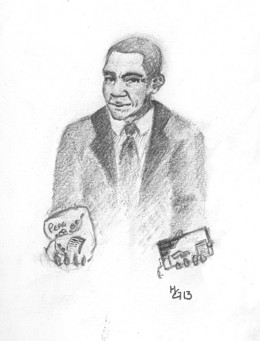
Dear Mr. President,
Following the example of our university president, Harvey Stenger, we chose to frame our editorial in response to your visit as a letter.
As the fanfare and euphoria subside following your town hall meeting in the Mandela Room, we are left with several tough questions in response to your plan for affordable education.
We think it’s great that you’re focusing on higher education’s importance and needs. It’s even more meaningful that you chose Binghamton University to call for student and faculty input on your plan for improving affordability.
But we have serious apprehensions about your plan for the future of higher education. What we love and believe in about Binghamton is that it as a university encourages thought, creativity and academic exploration. Your plan, as we understand it, would compile a ranking of universities based on graduation rates, retention rates, affordability and hire-ability, among other factors. As Secretary of Education Arne Duncan stated, graduation rates are your “North Star” for this plan, given the importance of a college education for young people. But pushing students toward online learning and fast degrees risks jeopardizing classical liberal arts values and calls into question what the real role of an institution of higher education should be.
President Stenger expressed similar apprehension about a rating system centered around dry, quantifiable measurements. His analogy, with which we wholeheartedly agree, uses the labels on food.
“In the grocery store, the candy bars are labeled and the frozen peas are labeled,” Stenger explained in an interview. “They use the same measurements and the same techniques to measure calories and nutrients, but they don’t tell you which is good and which is bad.”
While making a university’s “nutrition facts” accessible to students is important, a student’s decision about where to attend college should be based on more than a federally determined list.
Learning for the sake of learning, personal growth and intellectual expansion are the hallmarks of the ideal liberal arts experience. These are values you cannot quantify, measure or detect in any university’s stats. More so, we are not confident greater governmental involvement in the world of academia, outside of a funding framework, is what we want.
Graduation rates and hire-ability are admittedly serious concerns, especially given our extant economic climate. Still, we ought to be wary of letting post-recession employment and economic anxieties dilute the core of our identity as a liberal arts institution.
In a lot of ways, Binghamton exemplifies the cause of public education. And we’ve been doing pretty well when it comes to dealing with the tension between cherishing liberal arts values and grasping economic reality. We fear that standardizing expectations for universities will turn Binghamton, and other public universities like ours, into degree-granting factories.
We’re honored that you came here and listened to what we had to say. Now, we have faith that you’ll take these suggestions to heart as you finalize your plan.
Good luck to you, Mr. President, and thanks for coming in.
Sincerely,
The Editorial Board


